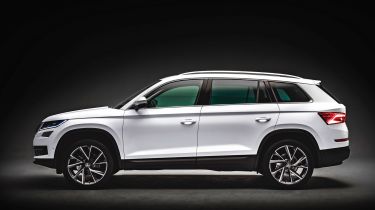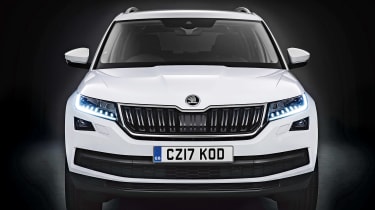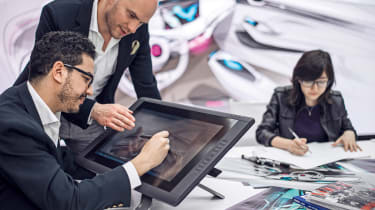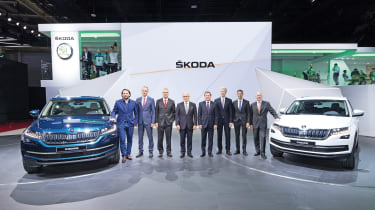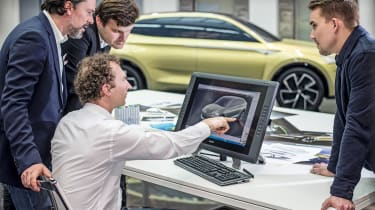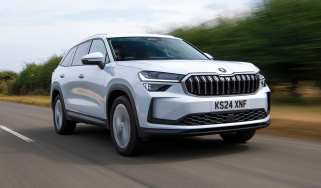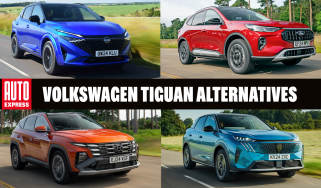How to design an SUV: creating the Kodiaq
We speak to the stylists behind the Skoda Kodiaq to find out how they overcame the challenges of designing the groundbreaking SUV
The Kodiaq is a landmark car for Skoda, in more ways than one. But it is particularly significant from a design point of view. With CEO Bernhard Maier setting out a plan to double Skoda’s sales by 2025, and SUVs playing a major role in achieving this huge sales expansion, it was vital that the Kodiaq set out a defined design blueprint for the brand’s future crossover stars.
The thinking behind this is already becoming evident; the recently unveiled Karoq so obviously follows the cues of its big brother – and is so fundamentally different from its predecessor – that it necessitated a name change, with the Yeti badge ditched in favour of a moniker that, like the Kodiaq, is sourced from the wilds of Alaska.
The men tasked with bringing the idea of a large Skoda SUV to life were head of design Jozef Kaban, who is shortly to leave the Czech company to take over a similar role at BMW, and Karl Neuhold, Skoda’s head of exterior design.
Styling a car for an area of the market where a brand has no presence, as was the case with Skoda and the large SUV sector, can often be a double-edged sword. Trying to work out how a model should look can be daunting, as the likes of Aston Martin and Bentley found out with their Lagonda and EXP 9 F SUV concepts respectively. But as Neuhold explains, Skoda’s concerns were overridden by the opportunity to create something from scratch.
He recalls: “We started in 2012/2013 with the SUV programme overall, and first we got the chance to focus on having a seven-seat SUV – something that would sit above the Yeti. In this case we would use the MQB A platform, and so the car would have a wider track.
“For designers, the best thing is to start with a white sheet of paper and a new programme – and this is what we had. When you have too much input from elsewhere, too many limitations, people telling you what it must be like… Forget it!”
Of course, the design team’s opportunity to express that creative vision still had to fit in to some clear parameters, as Neuhold acknowledges: “In 2014 we showed the Vision C concept [which gave a strong indication of how the Superb would look], with a very sculpted design and harmonious proportions, but still a very clean, clear, precise layout for the road cars. But for the SUVs we had to do something else, because we wanted to show bold, masculine, robust design – SUVs with an especially strong identity.”
Although Neuhold and Kaban were the men at the sharp end, ultimately responsible for how the production Kodiaq would look, at the outset Skoda was keen to get input from a host of sources, and so introduced an element of competition to generate the best possible pool of ideas for the car.
Listening to Neuhold reflect on the process gives a fascinating insight into the hours, days and months spent debating and perfecting the finer details that go into preparing a model for production sign-off.
He explains: “First there is the design briefing, the start-up. Then we have market research: ‘What are our competitors doing?’. From there you move on to the sketches, and what is important here is character, expression and attention to proportion.
“By this stage you have three or four proposals, definitely, with designers working in competition. And then it goes like a tennis competition when you select who goes out from four to two to one, and then continue with that one, squeezing it and squeezing it. With the Kodiaq, ideas evolved over time, because we had a design competition internally and step by step we came to the right way. We had three proposals – but there were many ideas; exterior, interior and with external partners. In the end it was decided on one of our in-house ones, and we completed it in the best possible way, giving us the chance to get a great car on the road.”
It sounds straightforward, but the reality is very different. Every new car presents fresh challenges, and that was the case with the Kodiaq, too. While most observers would agree the production car is very well resolved, a number of obstacles had to be negotiated, and one was evident from the start.
Frustrated by the boxy anonymity of some large SUVs on the market, Neuhold had a genuine desire to give the car a more dynamic look, but realised this could be a tricky task. He continues: “We got the technical package and briefing, with details of the wheelbase [in the Kodiaq it’s 2,791mm] and approximate height [1,676mm]. And that meant we had to fight when you see the seven-seat layout and the rear seats. The last row was really challenging.
“Look at seven-seaters normally. What do they show? Almost a linear roof and a steep back. But look at how dynamic the Kodiaq looks for a seven-seater. On the side profile, you have a super-dynamic greenhouse and the back is really sculpted to give the car drive.
“There were quite a few loops with this, but finally we got it. We had a presentation internally and we said: ‘We’re not there yet! I think we can fight it out with engineers on the top corners’. In the back you should not sit slumped, but upright. But with the back construction, everything is up where you don’t want it – the hinges of the rear door, the brake lamp. In the end it was a question of millimetres [getting it right].”
If executing the rear to perfection was one of the more difficult jobs on the Kodiaq, the front was a little less awkward, with the design concept dominated by this desire to give the car, as Skoda’s SUV flagship, a more robust, distinct identity. This had to be achieved in such a way, however, that it still instantly looked liked a Skoda. Diluting the brand identity was never an option.
Says Neuhold: “The Kodiaq still fulfils the brand DNA. It still has the Skoda logo starting from the dominant nose, the horizontal line running around the car, and it’s very clean, clear, precise, showing crystalline elements but this time in a very bold, authentic way.
“We also started with a very sculpted, three-dimensional bonnet. You keep the top line like a bend around the car; it’s not a simple line. The nose is strong – it’s almost like giving it the feel of a boxer. The eyes were integrated like the environment is much more strong, covering the eyes and then the grille. It doesn’t have fine ribs like the road cars, but double ribs. The effect is to give a really cool expression.”
The layout of the lights, in fact, was one of the elements that the Skoda design team realised was key to providing the new identity the Kodiaq was supposed to embody, so ensuring this was correct was one of the most crucial jobs.
If the designers had made the layout too similar to the likes of the Superb, there wouldn’t be enough to mark out the car as an SUV. If they’d made it too different, its innate Skoda identity would have started to have been lost.
“If you look at the four-eyed layout at the front, road cars have them quite far apart with the foglamps moved down, but on the SUVs we brought them up to create a new identity,” continues Neuhold. “The foglamps are in a more protected position and with the lighting on it shows it’s off-road. But this was challenging, because the main headlights are LED and we got the gap down to an absolute minimum of 107mm; this is now the top standard. We are quite proud of that. It gives the car a very unique look. Nobody has done it like this.”
One thing any design process needs is outside validation. That generally means holding clinics and presenting a concept, before awaiting the verdict of potential customers.
The Kodiaq went through this process, too, and it’s a tribute to the vision of the Skoda design team that its path to production was largely seamless. “Yes, we did clinics, and the feedback was really positive from the start,” recalls Neuhold. “People said it looks tough and strong, and that meant a lot.” The concept [the Vision S seen at 2016’s Geneva Motor Show] was obviously close to what was planned for the production car, and there was a good reason for that, because the design team had enjoyed the luxury of nearly two years’ work to get it right.
“We had to get it approved by the board members, but we’d showed how we wanted it in 2014,” explains Neuhold. “We had a design that was almost driveable where you could see the proportions.” After that it was tried and tested on the track to ensure it drove properly, so when it came to Geneva, the Vision S was very close to the finished article – it had to be. Neuhold adds: “Design is mainly proportion. You can decorate it how you want, but if the proportions are not right or it doesn’t have a good stance, it’s useless. So what you get there [the concept], you get in production.”
With the reaction overwhelmingly positive, the production green light pressed and the Kodiaq successfully unveiled last year and now in showrooms, it’s time for Neuhold and his team to reflect on what appears a job well done.
What’s he most proud of in the car that will lead Skoda’s SUV charge? “The overall expression,” he smiles. “It’s tough and very characterful. It’s a real statement and a true Skoda.” Few would disagree with that.
How the Kodiaq leads the way for Skoda’s SUVs
Skoda’s plan to double sales by 2025 globally means there’s a host of new SUVs on the way, and in terms of design, the Kodiaq will have a clear influence on what follows from the brand.
Skoda Karoq
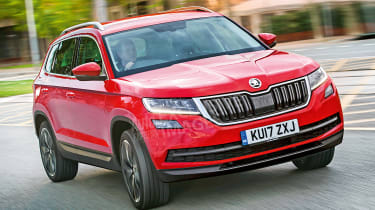
On sale: 2017
We’ve already driven an early prototype of the Yeti successor, and the influence of the bigger SUV is obvious. Neuhold says: “The old Yeti was polarising. The design was very different from everything. The new car is coming from the Kodiaq, but has its own identity as well.”
Skoda Kodiaq Coupe
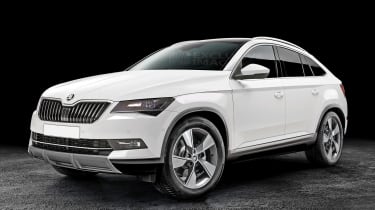
On sale: 2018
The coupe-SUV has exploded in popularity in recent years, and Skoda is set to join in with a new model set for launch in China next year, but still not confirmed for Europe. It’ll have a more swoopy roofline than the Kodiaq, but head of exterior design Karl Neuhold says it will “echo the styling”.
Baby Skoda Karoq

On sale: 2019
Another crossover in the pipeline from Skoda is a Nissan Juke rival that will sit beneath the Karoq. The car is already under development, company bosses have confirmed. It’s likely the newcomer will share its mechanical make-up with SEAT’s upcoming Arona.
Do you like how the Skoda Kodiaq has been designed? Let us know below...
Find a car with the experts
